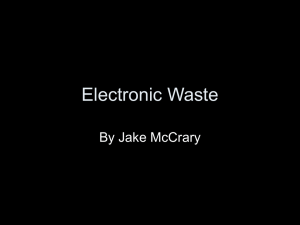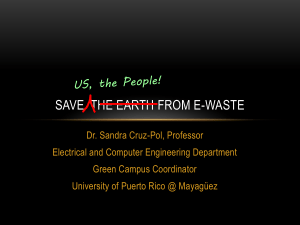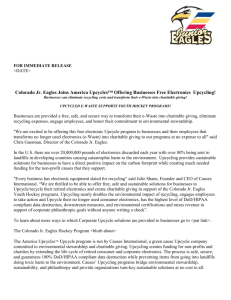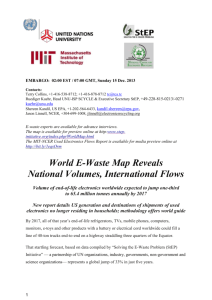Waste Material and Its Affect On Humanity
advertisement
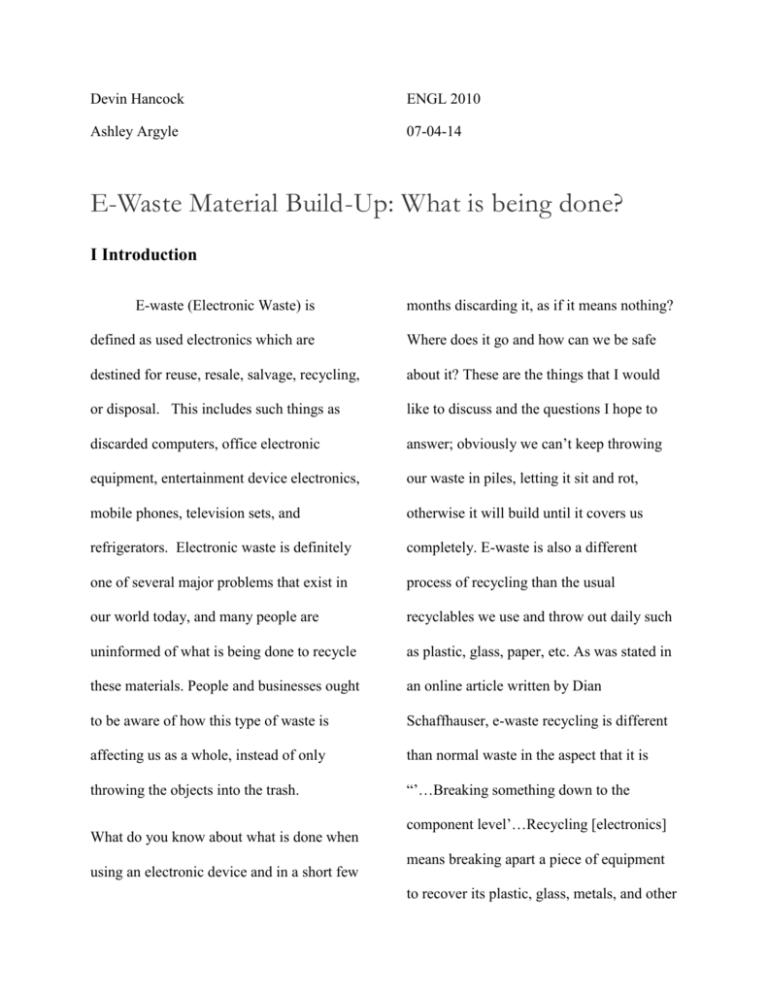
Devin Hancock ENGL 2010 Ashley Argyle 07-04-14 E-Waste Material Build-Up: What is being done? I Introduction E-waste (Electronic Waste) is months discarding it, as if it means nothing? defined as used electronics which are Where does it go and how can we be safe destined for reuse, resale, salvage, recycling, about it? These are the things that I would or disposal. This includes such things as like to discuss and the questions I hope to discarded computers, office electronic answer; obviously we can’t keep throwing equipment, entertainment device electronics, our waste in piles, letting it sit and rot, mobile phones, television sets, and otherwise it will build until it covers us refrigerators. Electronic waste is definitely completely. E-waste is also a different one of several major problems that exist in process of recycling than the usual our world today, and many people are recyclables we use and throw out daily such uninformed of what is being done to recycle as plastic, glass, paper, etc. As was stated in these materials. People and businesses ought an online article written by Dian to be aware of how this type of waste is Schaffhauser, e-waste recycling is different affecting us as a whole, instead of only than normal waste in the aspect that it is throwing the objects into the trash. “’…Breaking something down to the What do you know about what is done when using an electronic device and in a short few component level’…Recycling [electronics] means breaking apart a piece of equipment to recover its plastic, glass, metals, and other elements” (5). This is because e- Ready for End-of-Life Management (million of units) Disposed (million of units) Collected for Recycling (million of units) Rate of Collection for Recycling (by weight) waste consists of technological equipment and contains harmful In the Management of Used and End-Of-Life Electronics in 2009. Figure 1.1. 47.4 29.4 18 38% 27.2 22.7 Computers 4.6 17% Televisions elements like last few decades, the development of 141 increasingly 129 intricate 11.7 electronic 8% Mobile Devices devices has grown mercury and cadmium; these can be incredibly. Therefore, because each absorbed into the soil and eventually make individual wants the next best thing, it is their way into the local water supply, where often seen that we toss out the old very it is disposed and can poison possible frequently without thought of where it goes, consumers by seeping into the water and which can be detrimental considering how food. These are just some reasons why it is much is thrown out. For a more meaningful important to effectively dispose of these perspective, take a look at Figure 1.1, taken frequently thrown away ‘commodities,’ in a from the U.S. Environmental Protection way that keeps them useful several times Agency’s website (Statistics); the above over and eliminates the potential of build-up graph is an estimation of the number of which can have consequences for living electronics recycled in 2009 at the end of things and the earth we inhabit. their life cycle. 25% of overall electronics were collected for recycling, including such things as cell phones, laptops, desktops, unsafe, working electronics can be sold or monitors, TV’s, screens, etc. Although donated to businesses or consumers in twenty-five percent may seem like a big developing countries; though not reusing or number, consider that out of the 27.2 million recycling these materials does pose a units disposed of in 2009 only 4.6 million problem in the sense that there are units were collected for recycling, in environmental costs in transporting them as comparison to a number of 22.6 million well as lost opportunities for local economic units not being recycled! development. II Method 1 Challenges and Opportunities in the U.S.: Constantly Americans are buying new E-waste is not just a problem in the products and throwing away old ones— United States, more than approximately 40 according to Doctor Nancey Green Leigh-million tons of e-waste is generated around an estimated four hundred million per year the world (Leigh, p. 1). The Basel Action (4). The number of consumer electronics in Network (BAN) and other organizations the common U.S. house is increasing have tracked how dumping of this waste can drastically and for that increase in buying, result in illegal and harmful consequences. there is an increase in discarding. Leigh, These discarded electronics pose a serious Choi, and Hoelzel state, “The average U.S. threat to humans and cause environmental household owned twenty-five consumer risk when at the end of their useful life. All electronics in 2010, which is a 9% increase the plastics, metals, and other hazardous from the prior year” (Leigh, 5). Over 80% of materials are toxic when burned, crushed, the recyclables collected in the U.S. are left in landfills, or comingle with other exported; to the contrary, these materials waste. However, not all exported e-waste is could be kept here and used to create jobs in from households and individuals or order to maintain usage of the electronics by businesses into landfills. Between 2003 and refurbishing, reusing, and recycling them. It 2011, as many as 25 states, nearly 65% of is known that a portion of exported waste is the U.S. population have adopted some sort scavenged in developing countries by rural, of e-waste recycling law. The most common low-income workers in a way that is unsafe of those being the extended producer to humans and the environment. One responsibility or EPR, which requires that possible way to change the world would be original equipment manufacturers (OEMs) to develop a more sustainable e-waste be financially responsible for the recycling management industry and reduce of their products; this statute was set in place exportation which contributes to the not to get them to better make their products so necessarily needed recycling & exportation that it would reduce the difficulty and costs to developing countries. for disassembling and managing e-waste. III Results Due to these few things, these states with recycling laws have collected tens of The Resource Conservation and thousands of tons of e-waste. Recovery Act (RCRA), requires that exportation of cathode ray tubes (CRTs) be reported to the EPA and receive authority in order to dispose of the hazardous material; Items containing mercury are considered hazardous by the RCRA but the EPA does not possess authority to prohibit the disposal of the electronics in small amounts taken On another note, the need for ewaste recycling has done some good for the economy as well. As has been reported by the International Data Corporation it is estimated that there are approximately 600 to 1,000 companies that employ at least 30,000 workers and with their combined efforts, generate more than 5 billion dollars opportunity, meaning loss of employment in revenue per year (Leigh, N. G.). This is and also the ability to reuse and surely something that is multi-purposed in remanufacture items at the end of their life. ways that are beneficial as a whole to the There are many things in the recent decade earth and on a smaller scale, creating or so that have come about to protect our employment opportunity which may grow environment that involves recycling in the even more in the future. U.S.--e-wastes in particular--while also creating jobs for Americans. IV Conclusion In conclusion, recycling is a fairly new practice that has been an idea for a long time considering how much waste we as humans put into the world, yet has not been acted upon until recently. Much of U.S. ewaste that is dumped is mainly exported out of the U.S. to China or developing nations in order to scavenge but can be potentially harmful to them and the environment because of compounds left in the electronics. Another portion consists of the effects of exporting the e-waste, which causes the U.S. to lose economic Works Cited Anwesha, Anwesha, and Kunal Sinha. "Electronic Waste Management In India: A Stakeholder's Perspective." Electronic Green Journal 1.36 (2013): 1-21. Academic Search Premier. Web. 7 July 2014. Johnson, Tim. "Prospectors: The Next Generation." TCE: The Chemical Engineer 874 (2014): 28-31. Academic Search Premier. Web. 7 July 2014. Leigh, Nancey Green, Taelim Choi, and Nathanael Z. Hoelzel. "New Insights Into Electronic Waste Recycling In Metropolitan Areas." Journal Of Industrial Ecology 16.6 (2012): 940-950. Academic Search Premier. Web. 6 July 2014. Schaffhauser, Dian. "The Dirt On E-Waste." T H E Journal 36.3 (2009): 20-25. Academic Search Premier. Web. 6 July 2014. Statistics on the Management of Used and End-of-Life Electronics. 14 November 2012.u.S. Environmental Protection Agency. 06 June 2014 < http://www.epa.gov/osw/conserve/materials/ecycling/manage.htm>.

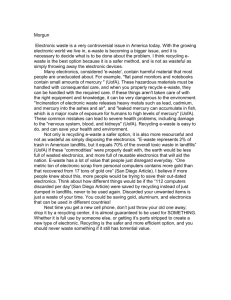
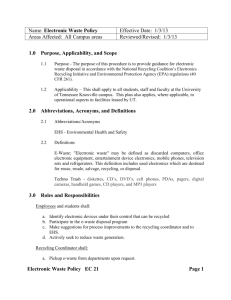
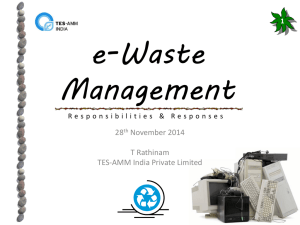
![School [recycling, compost, or waste reduction] case study](http://s3.studylib.net/store/data/005898792_1-08f8f34cac7a57869e865e0c3646f10a-300x300.png)
